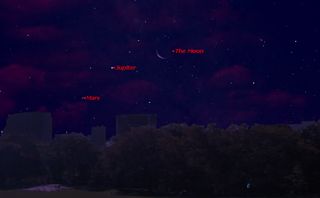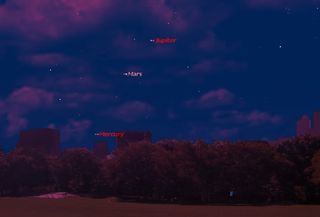
Over the next three mornings, set your alarm clock for about 75 minutes before local sunrise. If your skies are clear, you'll be able to see a "planetary triple play" low in the east-northeast sky.
Three bright planets in the August night sky will be stretched out in a diagonal line in the weekend pre-dawn sky. Going from upper right to lower left will be Jupiter, Mars and Mercury. And as a bonus, visiting each planet during these three mornings will be a waning sliver of a crescent moon.
To see the planets, plan to rise early at about 4:45 a.m. local daylight time. You can see a gallery of August stargazing events here to plan your skywatching activities this month. But for this weekend, here is a viewer’s timetable for early risers:
Aug. 3: Jupiter rises around 3:15 a.m. local daylight time. It is the most brilliant "star" before dawn. If you are outside during morning twilight, look toward the east-northeast to spot this last starry light that fades out before the coming of day. Jupiter lingers a few degrees to the right of the 3rd-magnitude star Mebsuta of the constellation Gemini, the Twins. Also this morning, situated about 7 degrees to Jupiter's right and slightly higher will be a slender waning crescent moon, 11 percent illuminated by the sun. Astronomers measure the brightness of objects in the night sky in magnitude, a scale in which brighter objects have lower numbers, with negative numbers denoting extremely bright objects.

Aug. 4: Mars is a yellow-orange dot of light, shining at a very modest magnitude of +1.6 (it would be categorized as second magnitude; just 1/25th as bright as Jupiter) and rises about two hours and 20 minutes before sunrise. In the following weeks, Mars will climb a little higher and as a consequence becomes easier to see, so too do the "Twin Stars" of Gemini, Pollux and Castor, situated to the left of Mars. And on this morning, about 5 degrees below and to the right of Mars will be a somewhat thinner (6-percent illuminated) waning crescent moon. As a reference, your closed fist held outstretched at arm's length covers about 10 degrees of the night sky.

Aug. 5: Look for Mercury very low in the east-northeast about an hour before sunrise. This small, fleet world gets lower each dawn in early August, but it also rapidly brightens, from magnitude -0.6 this morning to -1.3 (a trifle fainter than the brightest star, Sirius) by Aug. 13. On this morning, an exceedingly thin crescent moon – just 2 percent illuminated and about 36 hours from new – will lie about a half dozen degrees below and to the right of Mercury.
Keep in mind as you watch this changing celestial scene that each object is situated at a different distance from Earth. The nearest object of course, is the moon, near its apogee – the farthest point in its orbit from Earth – about 252,000 miles (405,000 kilometers).
Get the Space.com Newsletter
Breaking space news, the latest updates on rocket launches, skywatching events and more!
Next is Mercury at 91 million miles (146 million km), followed by a still-distant Mars at 222 million miles (358 million km) and finally there’' Jupiter, more than a half billion miles out at 554 million miles (892 million km) away.
Editor's Note: If you have an amazing picture of Jupiter, Mars, Mercury or any other night sky view that you'd like to share for a possible story or image gallery, send photos, comments and your name and location to managing editor Tariq Malik at spacephotos@space.com.
Joe Rao serves as an instructor and guest lecturer at New York's Hayden Planetarium. He writes about astronomy for Natural History magazine, the Farmer's Almanac and other publications, and he is also an on-camera meteorologist for News 12 Westchester, N.Y. Follow us @Spacedotcom, Facebook and Google+. Original article on SPACE.com.
Join our Space Forums to keep talking space on the latest missions, night sky and more! And if you have a news tip, correction or comment, let us know at: community@space.com.

Joe Rao is Space.com's skywatching columnist, as well as a veteran meteorologist and eclipse chaser who also serves as an instructor and guest lecturer at New York's Hayden Planetarium. He writes about astronomy for Natural History magazine, the Farmers' Almanac and other publications. Joe is an 8-time Emmy-nominated meteorologist who served the Putnam Valley region of New York for over 21 years. You can find him on Twitter and YouTube tracking lunar and solar eclipses, meteor showers and more. To find out Joe's latest project, visit him on Twitter.
